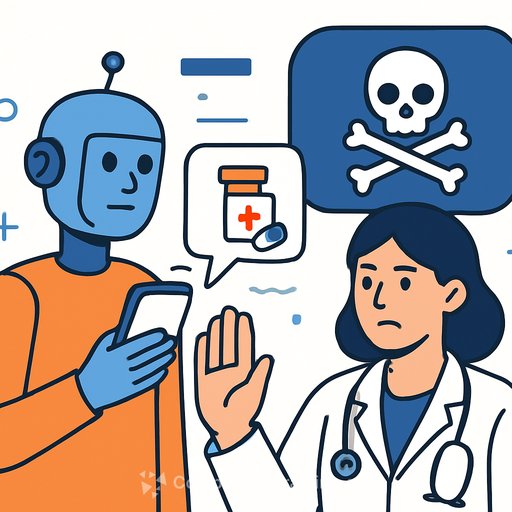AI Influencers Are Pushing Bad Medicine. Here's the Clinician's Playbook.
Artificial intelligence has already reshaped entertainment, marketing, and art. Now it's creeping into patient education feeds and health advice-often with false claims dressed up as certainty.
Houston emergency physician Dr. Owais Durrani is blunt about the risk: AI "influencers" are spreading misleading medical advice at scale. Recent studies show some AI tools echo incorrect claims-and even add fake details. The problem is less about the tech itself and more about trust, accountability, and reach.
Why this is accelerating
Three forces are pouring fuel on the fire: poor access to care, social media virality, and a steep drop in trust since COVID-19. During the recent West Texas measles outbreak, false narratives and high exemption rates worked against public health guidance.
We're also seeing the ethical mess play out in real time: a popular AI influencer staged a leukemia "reveal" for awareness and clicks, drawing backlash for exploiting patient trauma. On the regulatory side, the Texas Attorney General's Office resolved a case with a health-AI company that overstated its product's accuracy in hospitals-another sign of hype overrunning reality.
As Dr. Durrani put it: "When I post something online, I'm a credentialed physician. But with an AI influencer run by an individual or an organization, who are you going to call out? Who created this avatar? Who's funding it?"
The real risk to care teams
- Patients arrive primed by confident, wrong claims-delaying appropriate care or abandoning evidence-based plans.
- Increased inbox volume and staff time spent debunking content, not delivering care.
- Reputation and liability exposure if misinformation references your brand or staff.
- Confusion in outbreaks or crises where speed and clarity matter most.
What the research says
Bad information spreads faster than credible updates. One large study found false news propagates significantly farther and faster across social platforms, which tracks with what clinicians are seeing at the bedside.
A practical playbook for health systems and clinics
- Stand up a "health info ops" lane: Assign a small cross-functional pod (clinician lead, comms, legal, informatics) to monitor viral claims and publish quick, plain-language counters within 24-48 hours.
- Create preapproved rebuttal templates: 150-250 word responses for common topics (vaccines, supplements, weight loss, cancer cures, "biohacks"). Localize with your clinicians' voice.
- Proactive patient education: Add a one-pager to discharge packets and portals on "How to verify health claims." Include credential checks, red flags, and a prompt to message the care team before acting.
- Social listening with boundaries: Track trending claims that intersect with your service lines. Do not engage fuel-seeking accounts; route a calm explainer to your owned channels.
- Clarify internal escalation: Who reviews a risky claim? Who signs off on public replies? Where do staff report impersonation or deepfakes?
- Document the conversation: Embed counters and FAQs inside visit summaries, MyChart messages, and call scripts so every touchpoint reinforces the same facts.
- Measure: Monitor inbox volume, time-to-response, post reach, and changes in no-show or treatment adherence where misinformation is a factor.
Support clinicians who go online
Doctors are tired. Many avoid social platforms because of burnout and time. Yet a single short video can educate hundreds more people than a full shift.
- Give protected time or CME credit for digital education.
- Offer marketing support: editing, scripting, captions, accessibility, and fact-checking.
- Provide risk guardrails: HIPAA reminders, comment moderation, impersonation protocols.
- Publish under clinic channels to reduce personal harassment while amplifying reach.
As Dr. Durrani notes, "Hospitals should empower clinicians-help with editing, scripting, fact-checking-so we put out quality information instead of just billboards in white coats."
Fast heuristics to spot bad health advice
- Too good to be true: Miracle fixes, "no side effects," or "works for everyone."
- Credentials you can verify: Search licensing boards and professional profiles. Look for real affiliations and publications.
- Receipts: RCTs, guidelines, or consensus statements-summarized and linked.
- Conflicts disclosed: Who funds the account? Is there a product link or affiliate code?
- Close the loop with care: Encourage patients to run new supplements, diets, or protocols by their clinician. Everything has trade-offs.
Point patients to relationship-first care
Encourage people to establish primary care before they need it. That continuity reduces panic-driven decisions made off viral posts and gives patients a trusted source for quick questions.
Key talking points you can use tomorrow
- "I'm glad you brought this in-let's compare it to current guidelines and your labs."
- "There may be kernels of truth here, but the claims are overconfident and ignore risks."
- "If you see a big promise in a short clip, pause. Send it to us first. We'll sanity-check it together."
Bottom line
This isn't new; it's the modern version of the snake-oil pitch, amplified by algorithms. The fix is credible voices showing up consistently, systems that move fast, and a strong patient relationship that beats a viral clip every time.
As Dr. Durrani puts it, "We're on the same side of this. We're frustrated too. But we need to advocate together-for access, for better communication, for less stress in all our lives."
Optional: build team AI literacy
If your staff needs a quick primer on AI fundamentals to better evaluate claims, consider curated training paths by role. One option: AI courses by job for a structured starting point.
Your membership also unlocks:






